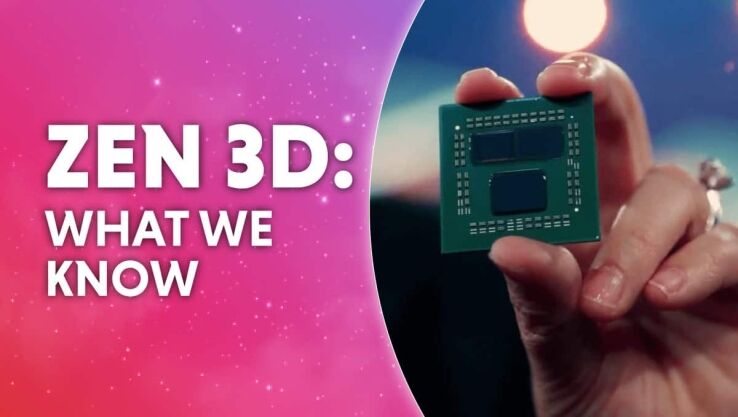AMD Zen 3D: Release date, price, and everything we know
Examining everything we currently know about the Zen 3D architecture from AMD.

WePC is reader-supported. When you buy through links on our site, we may earn an affiliate commission. Prices subject to change. Learn more
AMD recently released its flagship AMD Zen 3D processor, the Ryzen 7 5800X3D, and with it came much excitement around the new 3D V-cache technology the CPU is based upon.
The Ryzen 7 5800X3D managed to outperform the Ryzen 9 5950X and the i9-12900K in real-world benchmarks, despite having fewer cores and being burdened by a slower base and boost clock speed.
Now read: AM5: everything we know.
The Zen 3D series doesn’t stop at the 5800X3D, however, as there have been reports that AMD may be adding to the Zen 3D collection.
What is Zen 3D?
Zen 3D is a “rehash” of sorts focused on adding 3D V-cache to the existing Zen 3 architecture. We’ll get to 3D V-cache later, but integrating the new caching technology into AMD’s already existing architecture is no simple task.
The 3D V-cache requires some provisions to be put in place first as the cache is unstable serving cores at higher frequencies. The reason we think this is because AMD ditched overclocking support for the 5800X3D with no reason as to why.
This isn’t the first time AMD re-released / re-hashed a CPU architecture. AMD re-released its first Zen architecture under the name Zen+ (plus), adding some much-needed performance improvements and ironing out a few bugs that plagued Zen at the time. Maybe that’s AMD’s focus this time around too, fixing issues with the 5000 series.
What is 3D V-cache?
We’re going to discuss 3d V-cache as we know it to exist in the 5800X3D, as AMD may well have made some revisions to the 3d V-cache technology being integrated into the rest of the Zen 3D architecture.
The 3D cache is not stacked laterally but vertically, hence the term 3D cache. This drastically increases the number of chiplets you can fit into an area of any given size, thus resulting in larger cache capacities without sacrificing the cache access speeds. The vertical stacking allows AMD to achieve the massive 96MB L3 cache with a total access speed of 2TB/s in its 5800X3D CPUs. The massive capacity is achieved by layering two layers of 48MB cache on top of each other.
This has all been made possible thanks to AMD’s close relationship with its chiplet manufacturer TSMC/ this relationship allowed them to create a CPU using a new 3D packing technique.
This allows the CPU cache to be stacked on top of the 5800X3D’s Core Complex Die (CCD) while using a hybrid bonding approach that mixes copper-to-copper bonding with through-silicon vias (TSVs), not only does that allow the Zen 3 CPU cores and L3 cache to communicate and exchange data seamlessly, but it keeps the CPU profile slim. Allowing the CPU to retain compatibility with the AM4 socket and existing AM4 coolers.
Zen 3D release date
August 2022.
The supposed Zen 3D “rehash” is said to release at some point before Zen 4 and AM5. Meaning we could be looking at an August release.
Zen 3D rumor
Reliable Twitter leaker Greymon55, who has been proven to be correct many times, has indicated that “several” new AMD Zen 3 processors are due to hit the shelves at some point before zen 4 CPUs.
We’re supposed to hear more about this new mystery CPU line-up next month. So far, we’ve only seen the eight-core, 16-thread Ryzen 7 5800X3D boasting the 3D v-cache technology. Will AMD actually expand Zen 3D and release new CPUs this close to the launch of a new generation? And if so, why?
Why extend the life of AM4 just before the release of AM5?
AM5 like any other new integration will probably have some teething problems, in fact, we’re certain it will. But there are more than a few reasons we think AMD has done this.
AMD is probably looking to test its 3D V-cache technology further on a platform it’s already optimized and is very familiar with. Zen 3 is not only a platform AMD is familiar with, it’s a platform AMD knows its users are familiar with too. Meaning we’re going to better understand some changes to the platform and the implications of those changes.
We know for a fact AMD is releasing 3D V-cache integrated Zen 4 chips early on in 2024, but after the success of the 5800X3D, it’d be dumb not to explore what already works.
Back to the teething problems, as far as we know, Intel is going to try and cut AMD off with its release of it’s 13th generation Intel CPUs. Now, a new software integration that may have issues, coupled with a new rival release, and nothing more to offer than the previous generation, could drive users into the arms of intel.
If AMD extends the life of Zen 3 and AM4 just long enough to get AM5 through the teething phase, they could be looking at a way to keep users.
If you’re going to have to buy a new AM5 motherboard anyway, then you may as well buy an LGA 1700 motherboard and accompanying Intel CPU if AMD is proving to be unstable or full of bugs.
We’ll update this article as more news and information surrounding Zen 3D becomes available.